
Food and Beverage Trends to Watch in 2022 and Beyond

Trend #1: Plant-based Foods
While there is considerable evidence of people choosing to avoid animal products as far back as 2,000 years ago, today, 4 billion people live primarily on a plant-based diet.
Globally, the plant-based meat market will be worth $85 billion by 2030. The pandemic has only pushed the meat and dairy substitute product growth.
Beyond Meat and Impossible Foods have become very popular and are a force to reckon with in the plant-based meat industry. While they are not the first in the market, they have created meat substitutes that taste like real meat.
Plant-based foods such as snacks, dips, sauces, cheese, spreads, and creamers will see a double to triple growth within the following year.
Trend #2: Immunity Boosting Ingredients
The market for functional foods has been growing for years. However, demand has boosted since the onset of the COVID-19 pandemic.
As COVID-19 made the immunocompromised population more vulnerable, consumers became more interested in healthy foods that boost their immune systems.
Known as “functional foods,” these ingredients claim to possess an additional function. For gut health, examples include probiotic foods that contain beneficial microbiota, including fermented foods like kefir, yogurt with live active cultures, pickled vegetables, tempeh, kombucha tea, kimchi, miso, and sauerkraut. For inflammation, ingredients like turmeric, honey, green tea extract, fish oil, and ginger provide relief.
According to Beneo, an estimated 75% of consumers plan to eat and drink healthier due to the pandemic. The global market for these ingredients is expected to grow to $117 million by 2021.
Trend #3: Tastes of Homes
During times of unease, unrest, and uncertainty, consumers seek comfort in foods that remind them of happier, less turbulent times.
According to The International Food Information Council, many consumers are re-creating the restaurant experience at home by using meal kits, restaurant-branded products, and more sophisticated or flavorful ingredients from artisan food producers.
- Meal-kit service: In 2017, the industry was valued at US$4.65 billion, representing a 300 percent growth over the previous year.
- Speedy appliances: Another popular trend reveals many consumers purchased in-home appliances to make meal preparation easier.
The dinner with the family trend seems cemented in our behaviors and habits. Before the pandemic, 18% of households ate dinner together at home every day. Read the report to see the percentage of households that eat dinner together now, post-pandemic.

Trend #4: Transparency, Safety, and Sustainability
According to a 2020 Innova Consumer Survey, three in five global consumers say they are interested in “learning more about where their food comes from and how it is made.” The term ‘clean label,’ therefore, goes beyond ingredients. There is a need for transparency around the food being organic or additive-free, and companies need to show consumers they produced the food sustainably and humanely.
An increasing number of technologies are emerging to improve transparency, including radio-frequency I.D. tracking of ingredients throughout the supply chain and wireless/ smart technologies such as invisible barcodes.
Now that F&B producers and consumers are more experienced living with the pandemic, the focus is expected to shift toward sustainability.
ADM, a food technology company, observed that nearly two-thirds of consumers want their food choices to impact the environment positively. Lux Research’s report The Food Company of 2050 also lists “increasing sustainability” as a critical factor for increasing brand awareness and market share.
Source: Kadence International
